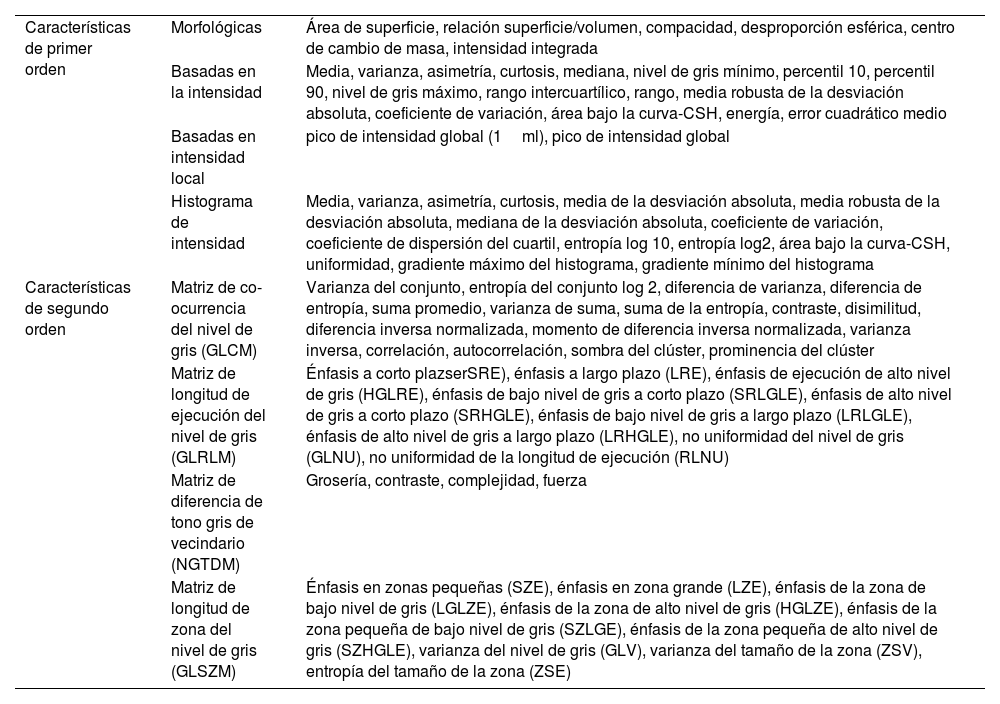El objetivo de este estudio es investigar el valor del análisis de textura de los tumores primarios en PET con [68Ga]Ga-PSMA pretratamiento en la predicción del desarrollo de recurrencia bioquímica (RB) en pacientes con cáncer de próstata que se sometieron a terapia radical.
MétodosSe incluyeron en el estudio 51 pacientes con adenocarcinoma de próstata que se realizaron una PET/TC con [68Ga]Ga-PSMA-11 pretratamiento y se sometieron a radioterapia (RT) con intención curativa o prostatectomía radical (PR). Se registraron las características demográficas, clínico-patológicas, la presencia de RB y la última fecha de seguimiento de los pacientes. Los parámetros de textura y convencionales de la PET (valor máximo de captación estandarizado [SUVmáx], lesión total-PSMA [TL-PSMA] y volumen tumoral de PSMA [PSMA-TV]) se obtuvieron a partir de imágenes PET/TC utilizando el programa LifeX. Los parámetros se agruparon utilizando el índice de Youden en el análisis ROC. Los factores que predicen la RB se determinaron mediante análisis de regresión de Cox.
ResultadosVeintinueve (56,9%) pacientes recibieron RT curativa primaria, mientras que los 22 (43,1%) pacientes restantes se sometieron a PR. Cinco (22,7%) pacientes con PR y 3 (10,3%) pacientes con RT curativa desarrollaron RB durante el seguimiento. El nivel de gris mínimo basado en la intensidad (p=0,050), la varianza de la suma GLCM (p=0,019) y la prominencia del grupo GLCM (p=0,050) se asociaron con RB en el análisis univariado. El nivel de gris mínimo basado en la intensidad (p=0,009) y la varianza de la suma GLCM (p=0,004) fueron predictores independientes de RB en el análisis multivariado.
ConclusiónLa heterogeneidad tumoral en la PET con [68Ga]Ga-PSMA previa al tratamiento se asocia con un alto riesgo de RB en pacientes con CaP que se sometieron a terapias definitivas.
The aim of this study is to research the value of the texture analysis of primary tumors in pre-treatment [68Ga]Ga-PSMA PET in the prediction of the development of biochemical recurrence (BCR) in prostate cancer patients who underwent definitive therapies.
MethodsFifty-one patients with prostate adenocarcinoma who had a pre-treatment [68Ga]Ga-PSMA-11 PET/CT and underwent definitive radiotherapy (RT) or radical prostatectomy (RP) were included in the study. Demographics, clinicopathologic features, the presence of BCR, and the last follow-up date of patients were recorded. Textural and conventional PET parameters (maximum standardized uptake value (SUVmax), total lesion-PSMA (TL-PSMA), and PSMA-tumor volume (PSMA-TV)) were obtained from PET/CT images using LifeX program. Parameters were grouped using the Youden index in ROC analysis. Factors predicting the BCR were determined using Cox regression analyses.
ResultsTwenty-nine (56.9%) patients have received primary curative RT, while the remaining 22 (43.1%) patients have undergone RP. 5 (22.7%) patients with RP and 3 (10.3%) patients with curative RT have developed BCR during the follow-up. INTENSITY-BASED-minimum grey level (P=.050), GLCM-sum variance (P=.019), and GLCM-cluster prominence (P=.050) were associated with BCR in univariate analysis. INTENSITY-BASED-minimum grey level (P=.009) and GLCM-sum variance (P=.004) were found as independent predictors of BCR in the multivariate analysis.
ConclusionTumor heterogeneity on pre-treatment [68Ga]Ga-PSMA PET is associated with a high risk of BCR in PCa patients who underwent definitive therapies.












